Achamanam information, meaning, mantra, procedure, significance, importance, benefits etc. | What is Acamana in Ayurveda? | What is the meaning of Achamanam mantra? | How do you perform Achamana?
Namaste friends, how are you doing today? Welcome to #BhagavanBhakthi website / blog.
Bhagavan Lord Sri Krishna (Vishnu) (Rama) (Trivikrama) and Goddess Sri Lakshmi blessings to you and your family!
In this website / blog, you will always learn about #Hinduism #Sanskrit language.
Also subscribe to my YouTube channel from this link #BhagavanBhakthi to view videos about #Hinduism #Sanskrit language.
Just before going to “Achamanam information, meaning, mantra, procedure, significance, importance, benefits etc. | What is Acamana in Ayurveda? | What is the meaning of Achamanam mantra? | How do you perform Achamana?“, let us know a brief, basic and very important information.
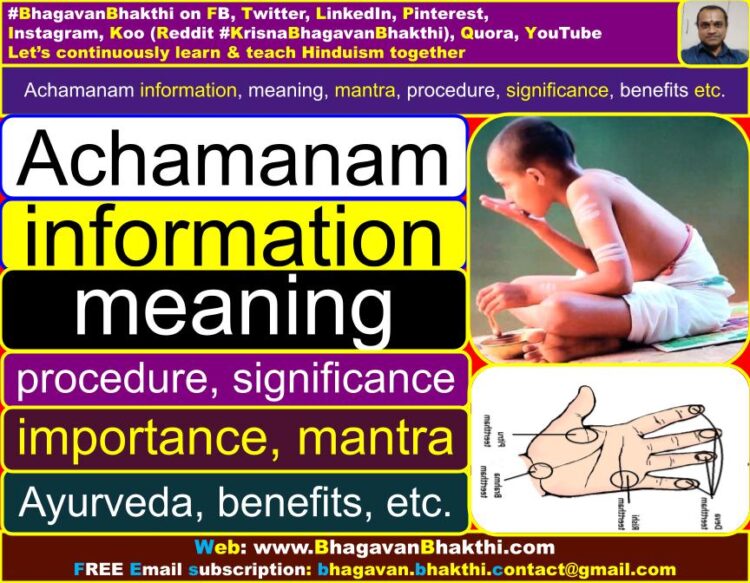
Achamanam is also pronounced as Achaman, Achamana, Acamana, आचमन, आचमनम्, आचमनं, ācamanaṁ, ācaman, etc.
In Hindu Sanatana Dharma sampradaya / tradition any nitya (daily) or Nymittika Karma (daily Karma) always begins with a sacred ritual known as ‘Aachamanam’ followed by ‘Sankalpam’ which has a dharmic and adhyatmic (spiritual) significance.
Aachamanam or Achamana or Achaman is very easy and very simplest of all the ‘Vaidika (Vedic) Karmas’. But still it is none the less in importance than even an ‘Aswamedha Yagnam’.
Achamanam or Achamana or Achaman importance can be well understood and realized when we note that Achamanam forms the prelude to all the rituals. We should note that ‘No Vedic karma begins without Aachamanam’.
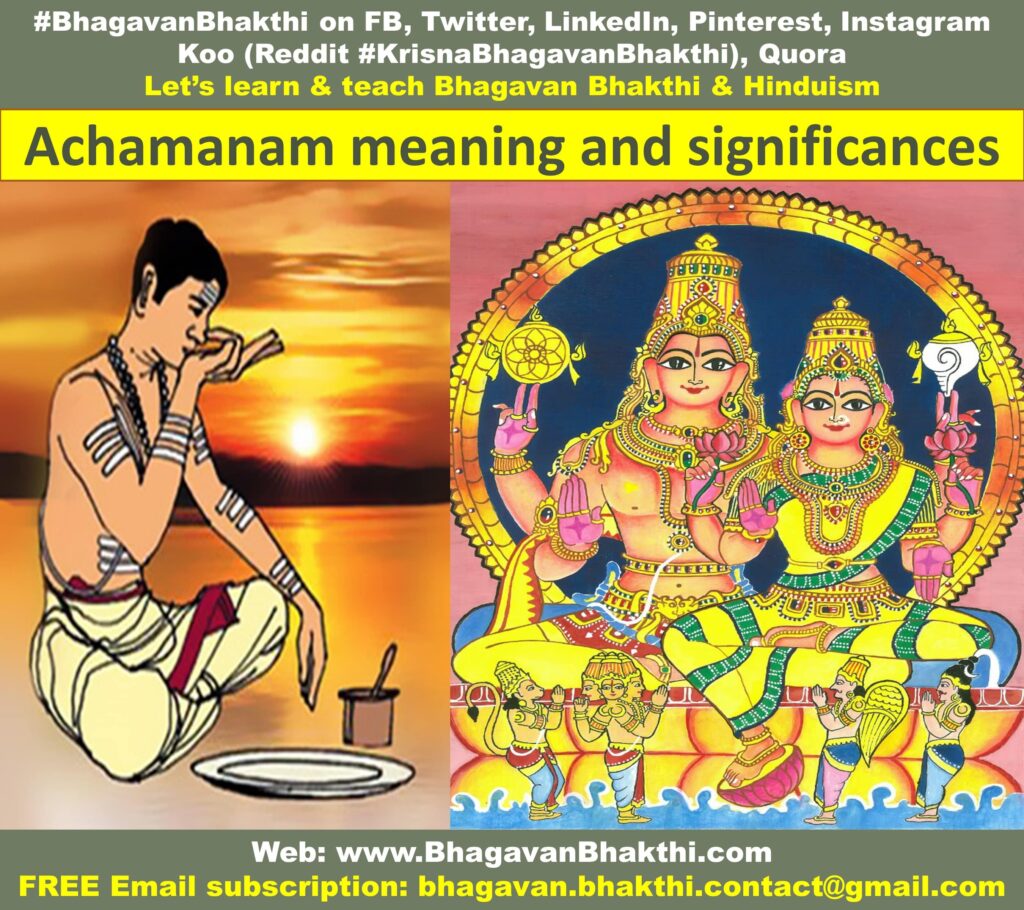
Meaning of Achamanam : The process of reciting the names of supreme Lord Sri Vishnu while performing ‘Jalapanam’ (sipping few drops of water) as per Vaidika Shastras (Vedic texts or scripts) is called Aachamanam.
Aachamanam is a purification ritual, wherein one sips some water three times from the ‘Brahma Theertham’ (base of the right thumb) while reciting divine names of Lord Sri Vishnu.
This is done three times to make ourselves free from three shortcomings, that is, ‘Kayika’ (physically), ‘Vachika’ (verbally) and ‘Manasika’ (mentally).
If may have observed in a temple that the priest offers ‘theertham’ (sacred water) three times to us.
Here number three denotes ‘Tridevas’ (Tri-Deities), that is, Lord Sri Brahma Deva, Lord Sri Vishnu and Lord Sri Maheshwara (Shiva). These Tridevas (Tri-Deities) also represent the three gunas, that is, Rajasa, Satvika, and Tamasika.
(We should note that Lord Sri Vishnu is free from all these three gunas. Here only example is given, so that the less intelligent can easily understand the terminology.)
(Because of this Lord Sri Vishnu is called as ‘Nirguna, that is, he is not affected by these three Gunas / qualities.)
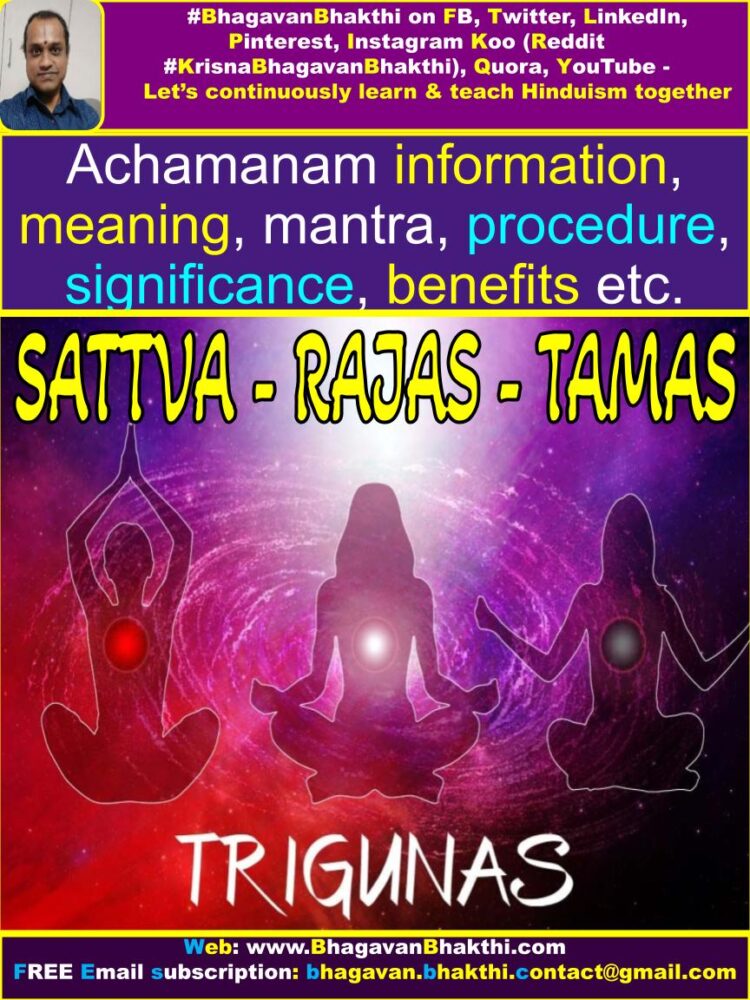
These same three Gunas (qualities) or states of mind are present in each and every human beings also.
Aachamanam is an act of purifying the inner body (atma / soul) by sipping some water while praying to Lord Sri Vishnu, the Primordial purushottama / best among all. Achamana literally means to sip some water.
But, as a ritual part of the purification, it means to sip some water three times from the right hand and then to touch the various sense organs and parts of the body while calling out the divine names of Lord Sri Vishnu.
This form of purification is in vogue since time immemorial (since unknown time). Few people tell Sanatana Dharma or Hinduism was started since 3k years or 5k years.
[This is completely incorrect as per Hindu Texts. Sanatana Dharma (Hinduism) is present since the unknown time. No one exactly knows about the exact timeframe of the starting of the Sanatana Dharma. Sanatana Dharma is cyclic process.]
Medicinal (Ayurvedic) benefits of doing Achamanam : The physical benefit and uses of this exercise is that,
by sipping some water thrice, the throat is cleared from ‘vata’, ‘pitta’ and ‘kapha’ doshas / problems and one is then able to chant the mantra or recite divine names of Lord Sri Vishnu very clearly.

How we need to perform Achamanam : Very simplest version of performing Achamanam is –
1. Firstly, we need to take a spoonful (Uddharana) of water poured into the cupped palm of the right hand (in Sanskrit this process of hand is called ‘anjali’),
2. Secondly, we need to recite “Keshavaaya Swaaha” and sip that water without making noise with the Palm tipped back slightly from the base of the thumb in the name of Lord Sri Keshava (right palm should be in the form of ‘anjali’).
3. Thirdly, same act is performed for the second time reciting of “Narayanaaya Swaaha” in the name of Lord Sri Narayana (another name of Lord Sri Vishnu).
4. Fourthly, the act is performed a third time reciting “Madhavaaya Swaaha” in the name of Lord Sri Madhava (another name of Lord Sri Vishnu).
(Please note that all the three names, that is, Lord Sri Keshava, Lord Sri Narayana and Lord Sri Madhava are the names of Lord Sri Vishnu. All are same names, but with different forms of Lord Sri Vishnu.)
Above same act is again followed by reciting the other 21 names of Lord Sri Vishnu called ‘Keshava Naamas’ (names of Lord Sri Keshava) by touching our various sensory organs and other parts of the body.
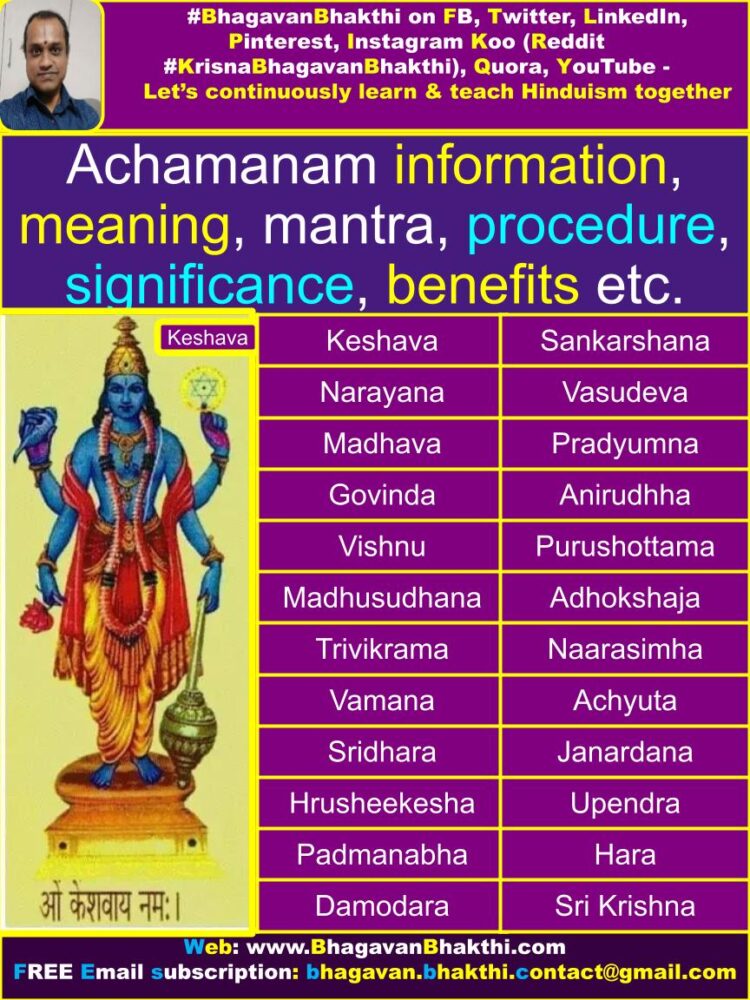
Lord Sri Maha Vishnu different names with our corresponding body parts are as given below (Achamana mantra):
1. Govindaya Namaha and Vishnave Namaha – Both the hands are washed
2. Madhusudhanaya Namaha and Trivikramaya Namaha – Both the upper and lower lips are touched with the right hand fingers.
3. Vamanaaya Namaha and Sridharaya Namaha – Left and right cheeks are touched
4. Hrusheekeshaya Namaha – Hands are touched.
5. Padmanabhaaya Namaha – Sprinkle water on the feet.
6. Damodaraaya Namaha – Centre of the head is touched with the middle finger.
7. Sankarshanaaya Namaha – Nose edge is touched with the fist.
8. Vaasudevaaya Namaha and Pradhyumnaaya Namaha – Left and right nostrils are touched.
9. Aniruddhaaya Namaha and Purushottamaaya Namaha – Right and left eyes are touched
10. Adhokshajaaya Namaha and Narasimhaaya Namaha – Right and left ears are touched.
11. Achyutaaya Namaha – Navel portion is touched.
12. Janardhanaaya Namaha – Chest is touched.
13. Upendraaya Namaha – Head is touched.
14. Haraye Namaha and Sri Krishnaya Namaha – Right and left shoulders are touched.
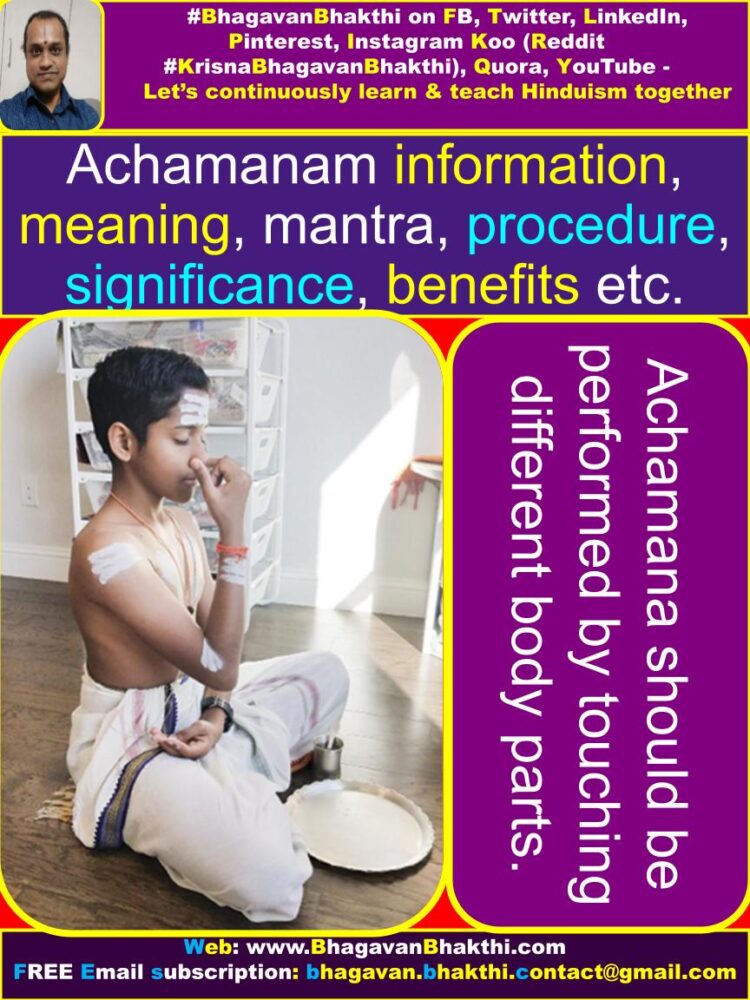
Different types of Achamanam is as given here: Achamanam may be of variety of types arising from different shastras / scriptures, that is, ‘Vaidika (Vedic)’, ‘Srauta’, ‘Smartha’, ‘Pouranic (Puranic)’ and also ‘Tantric’ based on the ceremony / ritual being performed and on the line of learning that is being followed.
There can also be difference in the rules followed. The difference may mainly lies in the mantras recited. Reciting of mantras during Achamanam differs from place to place, region to region based on sampradaya / tradition.
In some places we find people recite Achyutaaya Namaha, Anantaaya Namaha, and Govindaaya Namaha in the beginning while sipping water three times and thereafter 24 Keshava Naamas are recited by touching the body parts with fingers.
Generally family sampradaya / tradition is followed. Whatever may be the type of Achamanam followed, it’s very objective is one and the same, that is, purification of the body, mind and atma / soul.
It is said that Achamanam should be performed twice at the beginning of ‘Sandyaavandana Kriya’ (Sunrise and Sunset times) and once / twice at the end.

Practically, we find there are two types of Achamanam which are in vogue and they are:
1. ‘Sroutaachamanam’ and | 2. ‘Pouranikaachamanam’ (also called Smarthaachamanam.)
The one that is performed with ‘Gayatri mantra’ is called ‘Sroutaachamanam’ and the one which is performed with ‘Keshavadi Naamas’ (Keshava and other names) is called ‘Pouranikaachamanam’. Most of the people follow the system of ‘Pouranikaachamanam’.
It is said that while performing ‘Sandyaavandana Kriya’ one should follow the ‘Pouranikaachamanam’ and while performing ‘Brahma Yajna’ ‘Sroutaachaamanam’ should be followed.
How should be the Place & Posture while performing Achamanam:
1. The place we perform the Achamanam should be purified, cleaned, should be free from any impurities.
2. One should sit on an asana (wooden mat preferably) facing East (first preference) or North (second preference, if East facing is not at all possible) in Padma or Swastika asana.
3. Knees and feet should not be protruding.
4. One should not stand while performing Achamanam.
5. Always in Kukkutasana (hen-like posture) sitting down with the soles of the feet firmly planted on the ground, the hands between the knees.
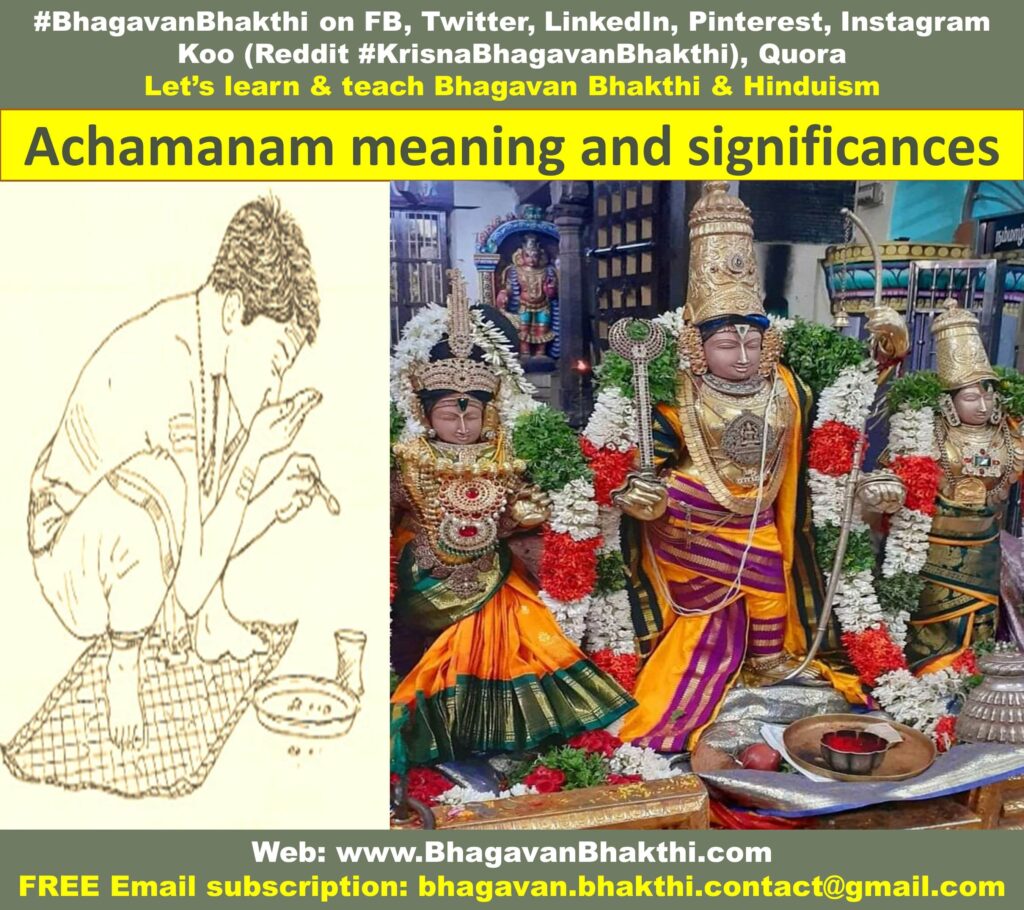
How should be our hand posture while performing Achamanam:
1. The right hand should be held so that the forefinger, middle finger and ring finger are together and slightly bent upwards.
2. While the little finger and the thumb are separated from the other three fingers.
How water is used during the Achamanam process:
1. Water used for Achamanam (for sipping purpose) should be pure, clean, normal room temperature water, but should not hot, without foam or stagnation bubbles, without foul odour or bad taste.
2. Water should be untouched by fingernails or hair or any other impure items.
3. Water should be of the quantity to cover a grain of Urad Dal (Black gram) should be poured from the left hand by spoon (Uddharana) (Panch Patra) into the right palm.
4. One should say the appropriate mantras and sip the water from the ‘Brahma Theertham’ (Uddarana) (Panch Patra) of the right hand without making any noise.
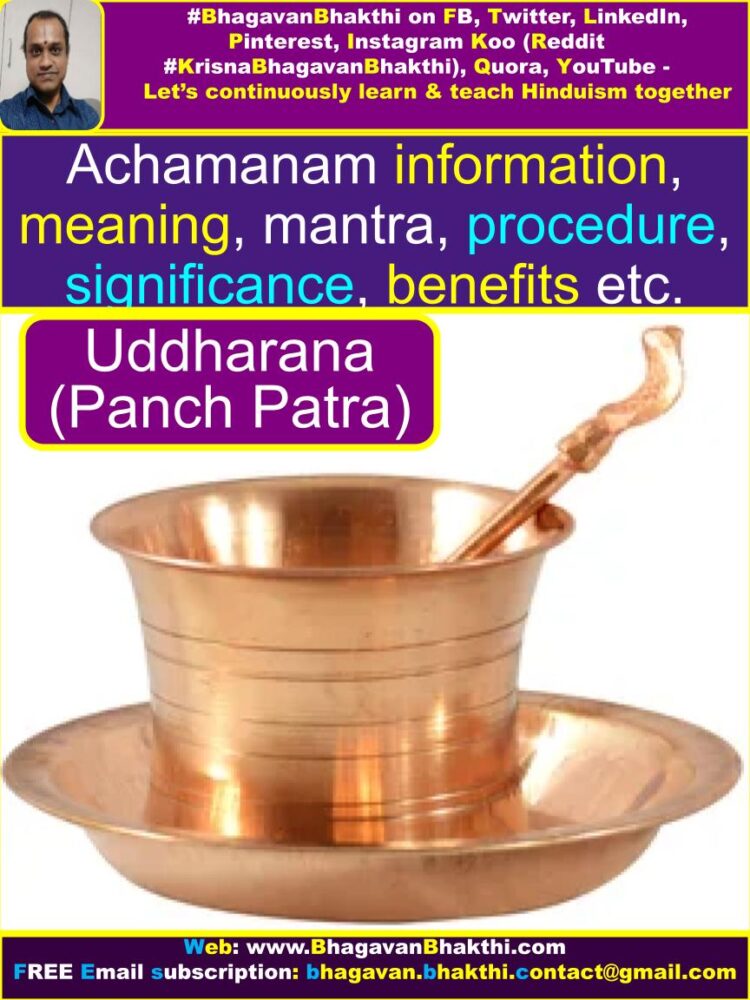
In our Shastras (Hindu Texts) it is said that a Brahmana (Brahmin) should always perform Achamanam using ‘Brahma Theertham’.
A Brahmana (Brahmin) can also do it using ‘Rishi theertham’ and ‘Deva theertham’, but he should never do it using ‘Pitru theertham’.
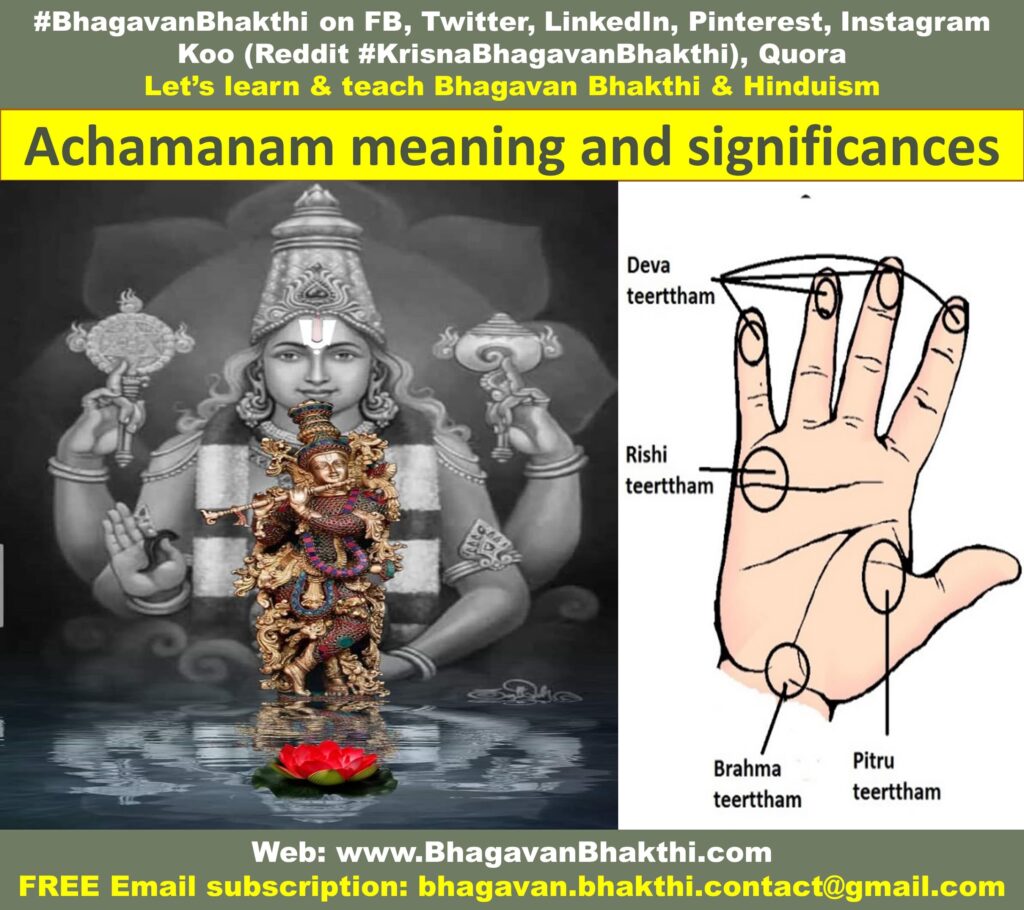
This classification is done based on where we hold the water in our right hand as given below:
1. If we hold it just below the thumb it is ‘Brahma Theertham’. | 2. If we hold it just below the little finger it is ‘Rishi Theertham’.
3. If we hold it at the edge of four fingers, then it is ‘Deva theertham’. | 4. If we hold it between the thumb and the first finger it is called ‘Pitru Theertham’. (See above image for more information).
When we can perform Aachamanam : Achamanam generally precedes all Karmas. There are specific occasions when it is called for / prescribed. They are as below:
1. As a simple preliminary to all nitya and naimittika karmas (daily rituals) like, Sandyavandanam, Devatha Archanam, Brahma Yajnam, Vedaadhyayanam, Pithru Yajnam (Shraddham / Tharpanam), Mantra Japam, Homam etc.
2. Immediately after waking up in the morning | 3. After completing urination and other forms of excretion. |
4. After brushing one’s teeth. | 5. Before and after taking bath. | 6. After wearing clothes. |
7. Before and after the meals. | 8. Speaking with or touching unsuitable persons. |
9. After telling a lie. | 10. Before and after giving or accepting alms or donation. |
11. After sneezing, shedding tears or blood. | 12. Upon physical contact with women. | 13. Before and after crossing a river.

When we shouldn’t perform Achamanam:
1. Achamanam should not at all be done in a standing posture. | 2. Exception is, one may perform Achamanam while standing if one is in water which is above the knees, but water should be below the navel. |
3. Achamanam is not to be done facing west or south. Should always be done facing east or north. | 4. Aachamanam should not be done with impure or falling water as from a tap or rain. |
5. But usually with water from a river or tank, or from a vessel held in the left hand. | 6. When doing in a river or tank, the left hand should be touching the water. |
7. It should not be performed casually and mindlessly: like while speaking to others, by wearing a shirt or footwear, with a covered head, with laughter etc. |
8. It should be performed with bhakti / devotion and with the consciousness that one is uttering the holy names of the ‘Almighty Lord Sri Vishnu’ who purify and protect us. |
9. Achamanam should not be done wearing a Pavitram (Yagnopaveetham / Janeu / Janivara). |
10. While performing Achamanam, Pavitram (Yagnopaveetham / Janeu / Janivara) should be kept in the gap between the right ear lobe and the head. This is perhaps meant to avoid the sharp ends of the Pavitram hurting the eyes. |
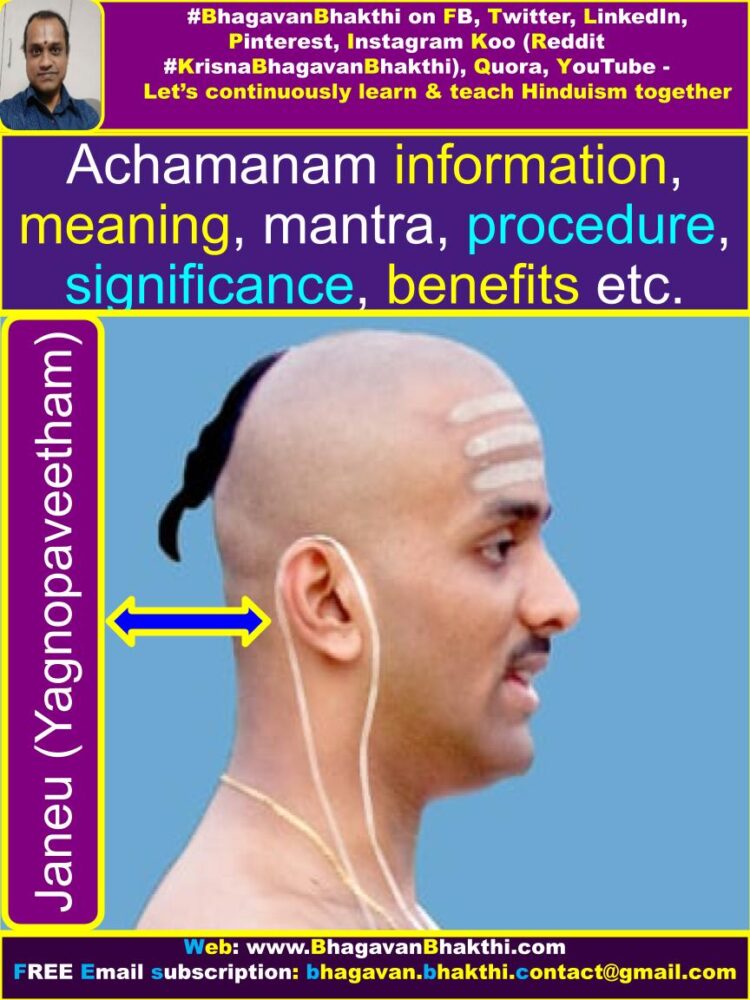
When Aachamanam is forbidden: Achamanam is not to be done immediately after taking ‘prasadam’ or sipping ‘theertham’. This is because as these are holy and pure and the symbolic act of purifying oneself through Achamanam insults ones’ holiness and sacredness.
Exemption from Aachamanam: There is one more type of Achamanam that is in vogue. It often happens like this:
Even though we need to purify ourselves through Achamanam, no water may be available at that particular time and place.
In such a situation our great shastras / scriptures prescribe an easy way of purification as below:
Just touching the tip of the nose and then the right ear uttering Pranava mantra.
It is based on the Shastras / Scriptural texts which say “Agni resides in the Brahmana’s nose tip and holy rivers like the Ganga and others in his right ear”. Hence simply touching these two purifies a person immediately.
One may have keenly observed elders reciting names of Lord Sri Vishnu like Sri Krishna, Sri Govinda etc., whenever they sneeze or yawn or cough etc. Perhaps this is with respect to the above principle itself.
It is to be noted that this shortcut is to be adopted only when performing regular Achamanam is not at all possible.

Significance of Achamanam: Jala / water is profusely glorified in our great Vedas and is used in Vedic rituals for sipping, touching to parts of the body, sprinkling over the body, and for bathing our body.
Taking pure, normal (room temperature) water internally is purifying and invigorating both physically and mentally.
When this is accompanied by utterance of the divine names of Lord Sri Vishnu, one becomes filled with adhyatmik / spiritual qualities.
Achamanam is a standard and easy form of purification, prerequisite for meditation, pooja, homa and other sacred and holy activities.
Note: 1. A Brahmana becomes purified by performing Achamanam if the water penetrates to the heart (i.e. by swallowing the water completely).
2. A Kshathriya becomes purified by performing Achamanam if the water reaches his throat.
3. A Vaishya becomes purified if the water reaches his palate (inside the mouth).
4. A Shudra or a woman becomes purified if the water touches his or her lips.
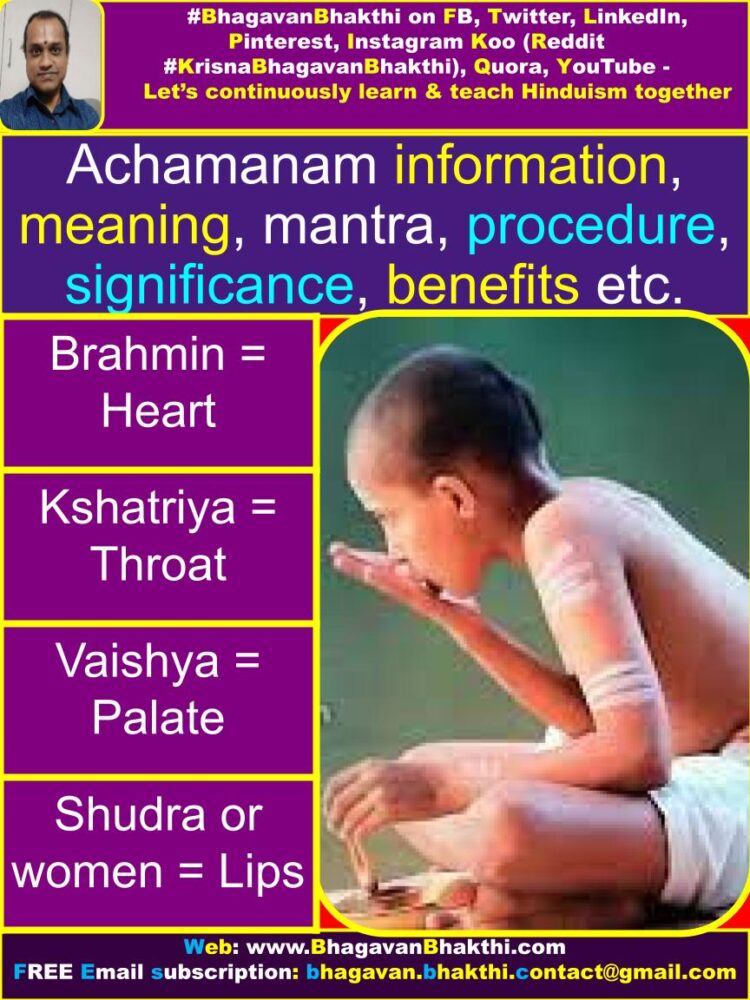
During Achamanam, one touches various parts of the body because in different organs of the body are located various energies and their abhimani Devatas / deities (controlling Demigods).
It is said in our Shastras (Texts) that, as per Lord (Sage) Sri Veda Vyasa (he is also an avatar of Lord Sri Vishnu), all the Devatas / deities are propitiated by the intake of water with the naamas / names of Sri Achyuta, Sri Ananta and Sri Govinda.
1. Wiping the lips pleases Ganga and Yamuna; | 2. Touching the eyes pleases Surya and Chandra. |
3. Similarly Ashvini Devatas are propitiated by touching the nose; | 4. Agni and Vayu by the ears. |
5. With the Padmanabha mantra all the thirty-three crore Devatas / Deities are pleased. | 6. And the Paramatma (Lord Sri Vishnu) is pleased by touching the head. |
When mantras are recited / chanted, a lot of heat is produced in the body due to which the throat and the mouth can become dry.
Achamanam done three times in a day, aims at remedying this dryness. One need not drink mouthful of water in Achamanam.
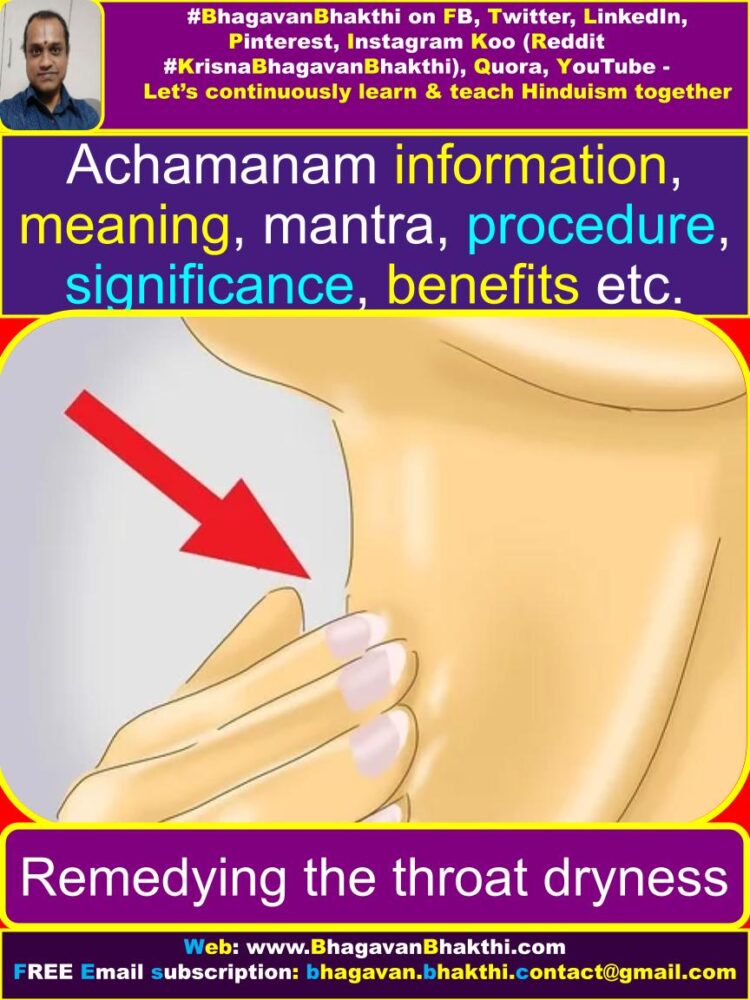
One needs to sip water as much as is required to make the mouth and throat wet and reach the heart.
It is said that any ritual performed without Achamanam and Sankalpam do not yield any results and is useless.
All Karmas performed without Achamanam are destined to fail and would be indeed futile.
|| “Anaachamyakritam yachha yachha sankalpa varjitam rakshasam thattbhavet.” ||
It is said as per Srimad Bhagavatam (Srimad Bhagavata Purana) that, Lord Sri Krishna had observed these rituals very strictly in his daily routine and shown to the world the significance of Achamanam and Sankalpam.
(We need to note that Lord Sri Vishnu or any of his avatars including Lord Sri Krishna, need not do anything to please anyone or anything. He is called as ‘atma kaama’ and doesn’t need anyone’s help or support.)
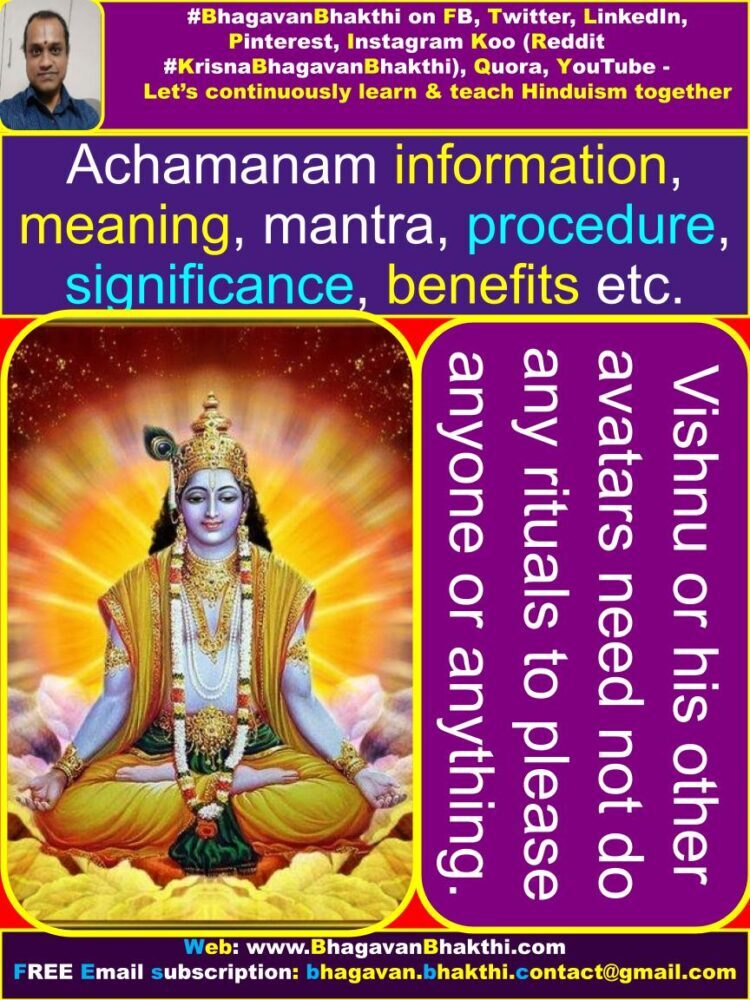
Achamanam and 24 Keshava Namas significance is as given below:
Among the unlimited naamas / names of Lord Sri Vishnu (Sri Vishnu Sahasranama), these 24 names are called as “Chaturvimshati Keshava Naamas” (24 names) are very important.
We recite these 24 names of Lord Sri Vishnu during Achamanam, the first three while sipping water and remaining 21 while touching the body parts.
Those naamas / names (24 Keshava names) are as given below:
1. Keshava, | 2. Narayana, | 3. Madhava, | 4. Govinda, | 5. Vishnu, | 6. Madhusudhana, | 7. Trivikrama, | 8. Vamana, |
9. Sridhara, | 10. Hrusheekesha, | 11. Padmanabha, | 12. Damodara, | 13. Sankarushana, | 14. Vasudeva, | 15. Pradyumna, | 16. Anirudhha, |
17. Purushottama, | 18. Adhokshaja, | 19. Naarasimha, | 20. Achyuta, | 21. Janardhana, | 22. Upendra, | 23. Hara, and | 24. Sri Krishna |
It is said in that ‘Manu Smruti’ compares these 24 names of the Lord Sri Vishnu with 24 tattvas (elements) of creation with which the universe is formed.
For example:
1. Kesava represents Avyaktha tattva, | 2. Narayana represents Mahatattva, | 3. Madhava represents Ahankara tattva, and | 4. Govinda represents Manotattva. |
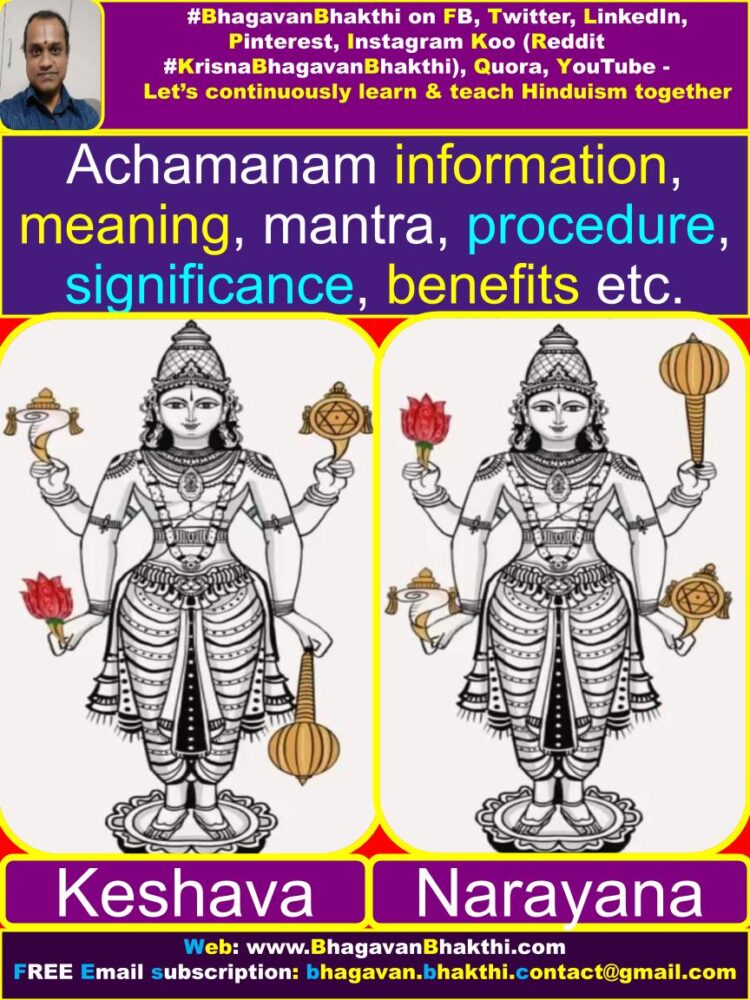
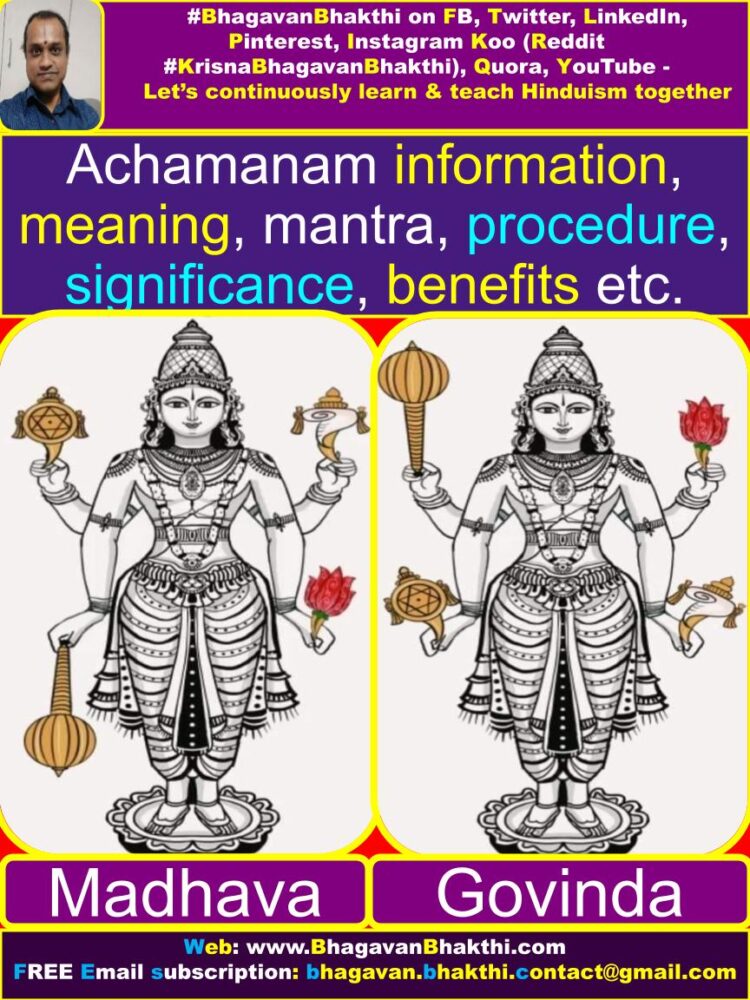
Remaining twenty names represents:
5. Pancha Gnanendriyas (eyes, ears, nose, tongue, and skin), | 6. Pancha karmendriyas, (hands, legs, speech, and two excretory organs), |
7. Pancha Pranas (prana, apana, vyana, udana, and samana) and | 8. Pancha Bhoothas (sky, water, fire, air, and earth). |
It is believed that, the first three names Keshava, Narayana, Madhava are Taapatraya Nivarakas (nullifying the problems).
These 24 names also represent the 24 syllables of ‘Gayatri Mantra’ called Beejaksharas that have influence on the human body.
For performing any Kriya / work, one should have ‘Anthhakarana Suddhi’ (purity of inner body) that is possible only by praying to Lord Sri Vishnu and by reciting Lord Sri Vishnu’s daivi / divine names (mantras). Also, the process of Achamanam is only meant for that purpose.
By reciting 21 names, a person is getting purified from bodily (physically) and by reciting three names a person is getting purified internally also.
Reciting these names of supreme God Lord Sri Vishnu is the link for bhakti / devotion, as it cleanses the inner body (atma / soul) of the human being that helps in attaining quick results.

The name of Bhagavan Lord Sri Vishnu is so powerful that it has the capacity to vanquish any papa karma / sins and desires.
Whether it is done knowingly or unknowingly with or without understanding its meaning and significance, reciting daivi / divine name of Bhagavan Lord Sri Vishnu will never became a waste.
Best example we find in the story of ‘Ajaamila’ as given in ‘Ajaamilopakhyanam’ of ‘Srimad Bhagavatam’ as given below (Ajamila short story):
In the story, as per called Ajaamila (Ajamila) chants unknowingly the name of Lord Sri Narayana at the time of his death and gets rid of all his sins which he had done until date.
The one that is done by knowing its meaning and significance will not only eliminate the sins but also helps in gaining the daivi / divine knowledge that leads to ultimate salvation, that is ‘moksha / mukti’ (a permanent place in Vaikuntha).
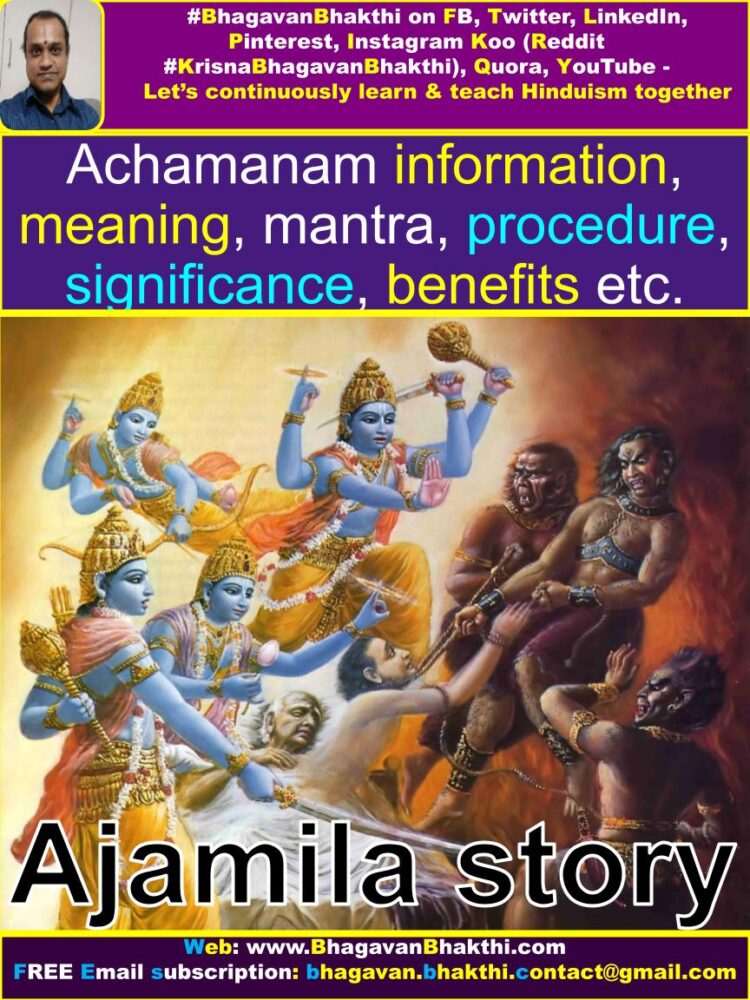
Achamana Vidhi / rules for inner cleansing is prescribed by our great Rishis Lord (Sage) Sri Vedavyasa (He is an avatar of Lord Sri Vishnu).
We need to wash our hands and legs and face, keep the sacred thread (Yagnopaveetham / Janeu / Janivara) in normal position, and keeping both hands in between the knees, we have to do Achamana.
Later, we have to clean our teeth. We need to make our right hand in the shape of the ear of the cow (form of ‘anjali’) and take water three times.
Then, we need to wipe our lips twice. Keeping the thumb and little finger open and folding the other three fingers, we have to drink the water. This is called the Achamana method.
Every time, you have to take water sufficient to drown a single grain of black gram.
Achamanam as per Marichi: Dharmic Achamana should not be done standing or sitting firmly on a chair or with hands held outside the knees. Immediately after meals Achamana can be done sitting firmly on the earth.
We should not do Achamaneeyam with upper cloth worn on one side of the body or with cloth hiding the shoulders.
It should also not be done without sacred thread (Yagnopaveetham / Janeu / Janivara), wearing dirty cloths and not tying the hair.
All activities following such wrong Achamanam need to be repeated again. If Achamanam is done facing south or west, then we need to take bath again and perform Achamanam again facing East or North.

Achamanam as per Lord Sri Yama Deva: While we are doing Achamanam, we have to touch water (pot or river) with our left hand. This is because in the left hand reside the twelve Adityas as well as Varuna the Devata of water.
Water in the Bronze vessel, copper vessel and silver vessel will always pure and will be free of any bacterias. So we have to hold the Uddharana (ceremonial spoon) and take the water from the vessel and pour it in the right hand and do Aachamana.
Taking it directly by the left hand is considered equivalent to drinking of Alcohol.
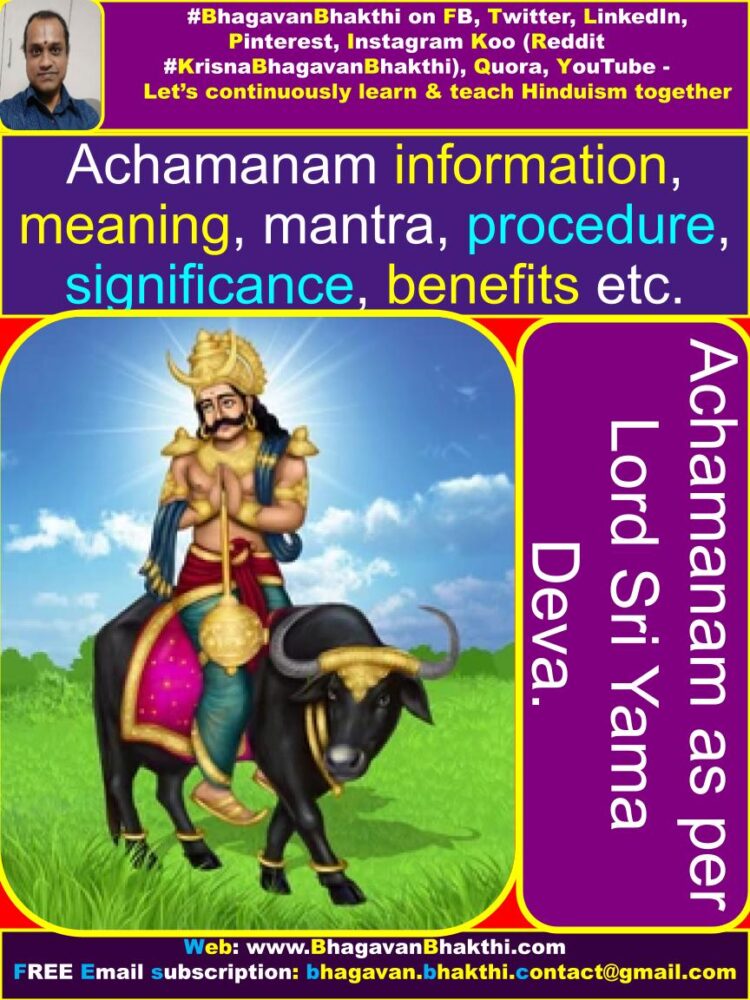
Achamanam as per Manu: The great and yet the simple Achamana should be done using ‘Brahma theertha’ which should not be hot, but should always be facing east or north.
For getting clean we should bathe in water reaching up to the chest in case of Brahmana, reaching up to the neck in case of Kshatriya, reaching up to the mouth in case of Vaishyas and reaching up to the bottom of the mouth in case of Shudras and ladies.
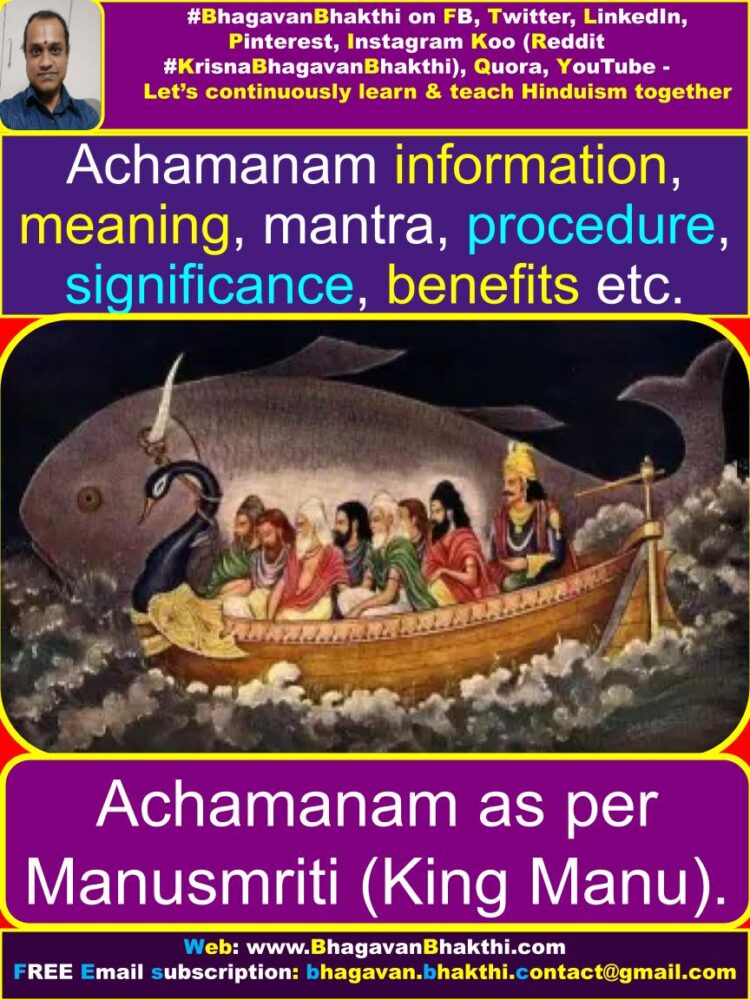
Achamanam as per Samvartha: Achamanam must be performed after bath, after taking food, after drinking fluids, after sneezing and after sleep.
If during chanting of mantra, we happen to see anything dirt, Achamanam should be performed and chanting recommenced.
Achamanam as per Markandeya: After eating mango, sugarcane piece, betel leaf and Soma Paana, there is no need to do Achamanam. After taking the Vishnu Paada Theertha also Aachamana should not be performed.
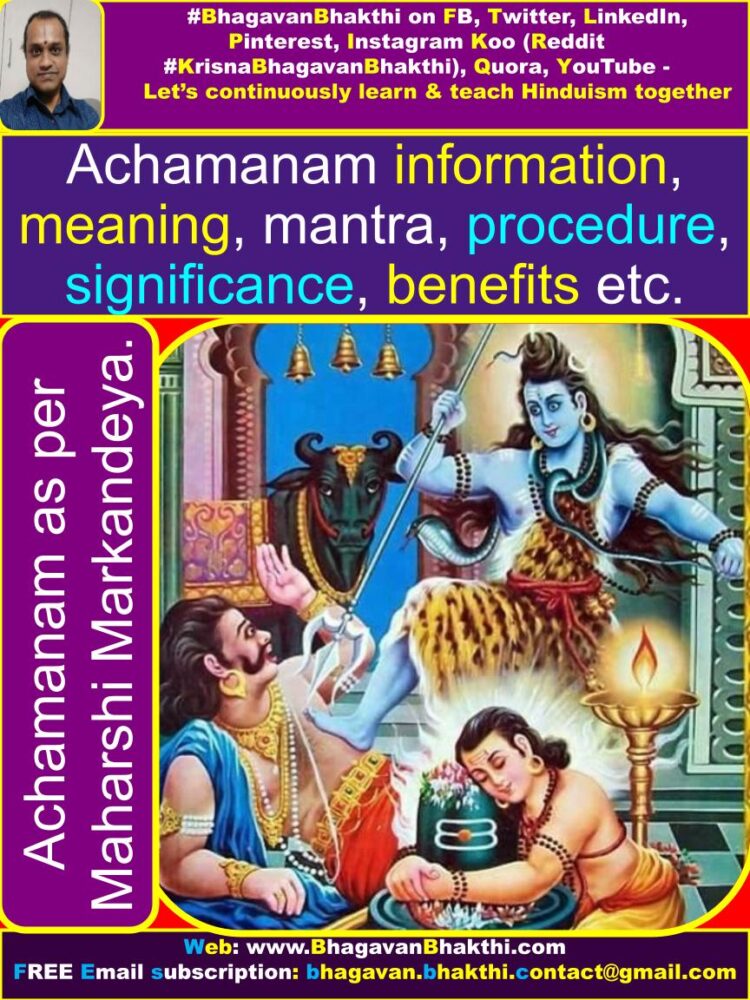
Achamanam as per Parashara: Manu and Parashara are of the opinion that the sacred waters of the river like Ganges & other rivers, Sun, Varuna, Chandra, Fire and wind are always in the right ear of a Brahmama.
When we have to do Achamana, at that time if we are not able to do Achamanam for any reason, or if we are not able to get water for Achamanam, we need only have to touch our right ear.
This is equivalent to Achamanam. But this has to be done only during rarest of the rare cases.
During meals, Homa, taking of alms, eating, or giving of alms, we need to perform Achamanam twice.
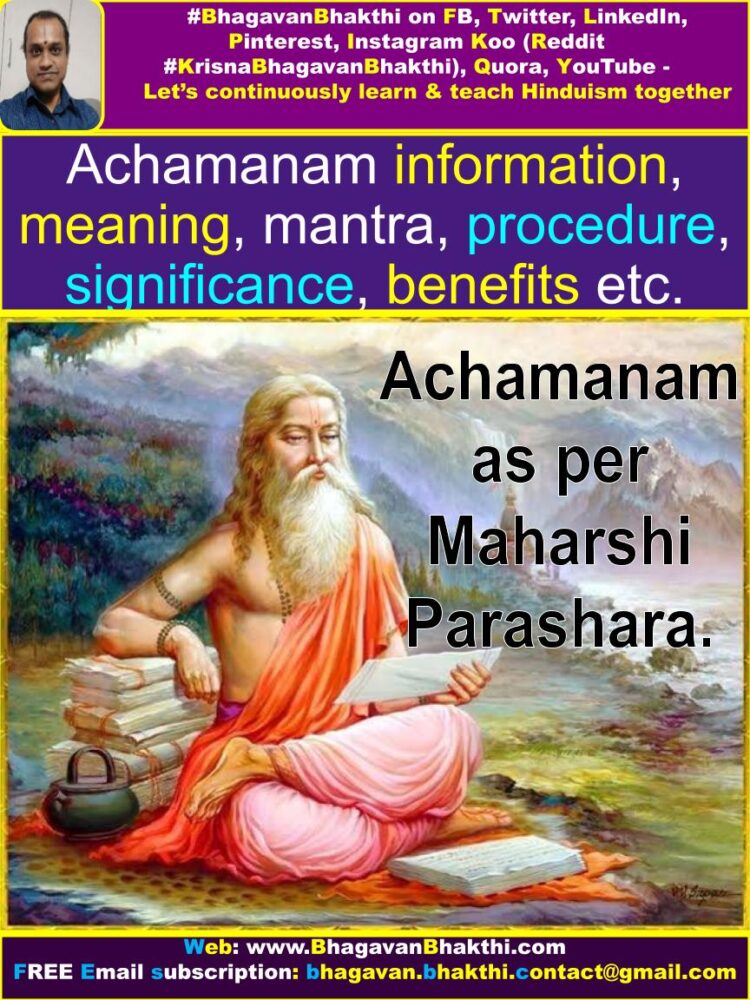
Achamanam as per Shaunaka: The water has to be taken after washing our both hands and legs.
The water that we see clearly should be used. The water which can just drown a black gram should be taken and it is sufficient if it reaches up to the chest.
After the Aachamanam, we have to close our lips and wipe the mouth by the base of the thumb twice.
Then we have to touch our mouth by all fingers held together. It is said after this, all organs should be touched by the fingers.
We should drink the water by saying: “Achyutaaya Namaha, Anantaaya Namaha and Keshavaaya Namaha”, and touch the organs using fingers chanting the 12 names of Lord Sri Vishnu.
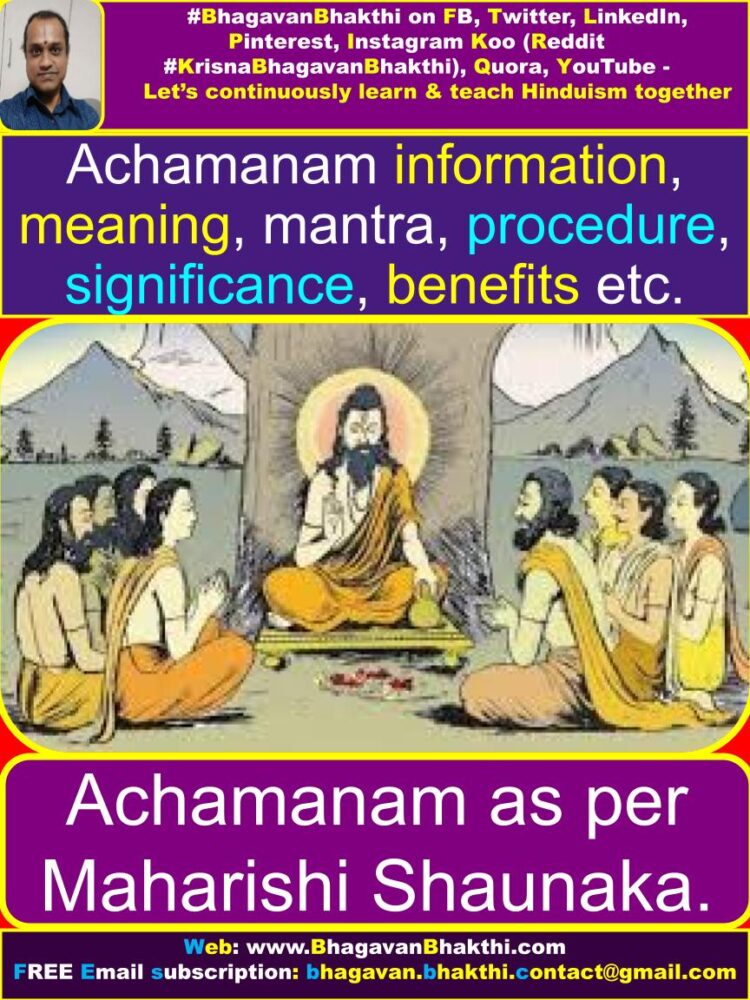
Let’s know more info about Bhagavan Sri Krishna by clicking the below link:
About Bhagavan Lord Sri Krishna
Continue reading about Hinduism (Sanatana Dharma) :
Ramayana information, facts, significance, importance, etc.
Maharishi information, facts, importance, significance, etc.
Rivers information in Hinduism (Sanatana Dharma)
Hinduism (Sanatana Dharma) information, facts, etc.
Mahabharata information, facts, significance, importance etc.
More information will be added to his post (article) on regular basis. Please visit again to know the updated information after some time.
To watch videos on #Hinduism #Sanskrit language, SUBSCRIBE to my YouTube channel from this below link:
#BhagavanBhakthi YouTube channel
To know more about “Lord Sri Vishnu stories, information, facts, significances, etc.“, please click the below link:
Lord Sri Vishnu stories, information, facts, significances, etc.
Dear friends, if you need any clarifications about this post, kindly let me know, I will definitely try to answer all of them.
Also your one LIKE, one COMMENT, One Share, one SUBSCRIPTION is highly important.
This will help to know the quality of this content and also it will be helpful to know if any improvements is required for the content.
If you feel this content is useful to you and has helped you to improve your knowledge, kindly share this with your well-wishers.
Because “SHARING MEANS CARING”.
For receive FREE EMAIL SUBSCRIPTION about #BhagavanBhakthi, you can send an email to bhagavan.bhakthi.contact@gmail.com from your email ID.
NAMASTE!
SRI GURUBHYO NAMAHA
OM NAMO NARAYANAYA
Sri Krishnaarpanamastu
Share in Social Media
Exhaustive nice presentation
Dear Raghu Ji,
Dhanyavad for your comment. Do read my other posts too, to know more about #Hinduism #SanatanDharma. Keep in touch.
Shubhamastu!
मैं आपके काम से खुश हूं। बहुत-बहुत धन्यवाद… प्रणाम
श्रीमान् अन्द्री जी,
आप के कामेन्ट के लिये धन्यवाद|
शुभमस्तु!
सत्य की जीत
Hare Krishna, All info knowledgeable
Nishikant Bolar,
Hare Krishna. Shubhamastu!
Sir does keshavaya swaha cures hair problem
Varun Ji,
Yes. Similarly, also chant Sri Keshavaaya Namah.
Shubhamastu!
non dwija can perform it?
i know it’s for dwijas
any other way like agamic,puranik like that